3 More Defectors Forced to Return to North Korea by the Moon Government in 2018; Defector: Hundreds of North Korean Boats with Defectors Forcibly Returned to North Korea in 2017 & 2018
2022-12-19, Tara O
The Moon Jae-in Administration (10 May 2017-9 May 2022) sent back 2 fishermen defectors to North Korea against their wishes in 2019, and the defectors say they were executed upon return. This case was widely reported, but it was not the only instance.
In December 2018, the Moon administration sent back 3 North Korean defectors against their will to their certain death, another defector Kang Chol-hwan said on his YouTube channel, Pyongyang 24 Hours, on December 20, 2019 (Seoul time). Kang explained that Japan found the boat with the defectors in the Sea of Japan / East Sea near Dokdo (Takeshima), the sea area jointly administered by both South Korea and Japan, and was investigating it, but the Moon Administration, after receiving information from North Korea’s Ministry of State Security (Bowiguk, counter-intelligence) that the boat is headed to Japan, sent the South Korean Navy destroyer Gwangweto the Great to intercept the defector boat and force it into South Korean waters. (0:34) Kang was certain that the soldier defectors would have made their intent to defect clear to South Korean authorities, if there was an investigation, but they were forcibly sent back by the Moon administration after only 3 days. (6:18) They were killed in miserable condition in a basement jail cell of North Korea’s Bowiguk a week after they were sent to North Korea, according to Kang. (7:08)

Kang stated that there were two assassination attempts against Kim Jong-un just before the above incident at sea. The first one was revealed by North Korea’s Ministry of State Security, which announced that an anti-regime, anti-communist organization conspired with foreign powers to eliminate “Choigo Jonum” (Supreme Majesty) and released a photo of a military tribunal. (1:40) Kang clarified that an anti-North Korean regime organization that includes some members of North Korea’s Ministry of State Security attempted to assassinate Kim Jong-un via explosives at an event at Pyongsung City, South Pyongan Province. (1:22) It failed.
There was another attempt in the Wonsan-Kalma area. Kalama is on the coast and is the location of Kim Jong-un’s key tourist resort development project. To build the beach resort, North Korean authorities mobilized 120,000 soldiers and 20,000 local residents for unpaid and harsh labor. Some of these mobilized soldiers became discontent and decided to eliminate Kim Jong-un if he visits the area. (2:47)
Their plans were discovered and these groups of soldiers were arrested wholesale, except for 4 key members, who succeeded in escaping the area in a boat. (2:45) During the escape 1 of the 4 escapees died on the boat. Instead of steering toward the south, the defectors went toward Japan, passing the Dokdo (Takeshima) Islands. They feared that if they went to South Korea, the Moon government would send them back to North Korea. Their fear came true.
Kang explained that it is because the intended destination was Japan, as the current from Dokdo flows toward Japan, and they did not want to go to South Korea under Moon Jae-in, whose position is pro-North Korea. (3:45) Numerous Koreans defected from the north via boats, but the Moon Jae-in government, which came to power in 2016, sent them back. (3:56)
Indeed, about 250-258 wooden boats from North Korea carrying defectors were sent back to North Korea in 2018 alone, with a similar number of boats returned in 2017, according to Kim Tae-hee, a defector. She and other defectors protested in front of the Ministry of Unification, when Lee In-yong (이인영), known for his Jusapa (KimIlSungism) background, was the Unification Minister and Suh Jeong-bae (서정배), was his Chief of Staff. (Note: Suh Jeong-bae apparently is still at the Unification Ministry, continuing many of Moon Jae-in’s pro-North Korea policies.)
The Japanese authorities discovered the boat and confirmed that there were 4 on board. (5:13) Kang stated that the Republic of Korea (ROK) Navy Gwanggaeto destroyer arrived and forced the boat toward South Korean waters, even targeting its fire control radar upon the Japanese surveillance aircraft, chasing it away. (4:53)
Kang is referring to the incident on December 20, 2018 when there was indeed a North Korean fishing boat that the Korean authorities said was being rescued. This incident made the headlines because the Japanese patrol aircraft pilot was threatened by the fire control radar pointing at it from the ROK Navy warship, which can be interpreted as a hostile act because it places the target, in this case the Japanese P-1 aircraft, in imminent danger.
According to Japan’s Maritime Self Defense Force,
“At around 3 p.m. (JST) on December 20, 2018, a fixed-wing patrol aircraft (P-1), belonging to the Fleet Air Wing 4 of the Maritime Self-Defense Force (MSDF) (Atsugi), conducting intelligence collection and warning and surveillance, was irradiated by a fire-control radar from a Republic of Korea (ROK) Navy’s destroyer off the coast of the Noto Peninsula. Fire-control radars are directed at its target immediately before firing, and to aim it at foreign aircraft is an extremely hazardous act that may cause unintended consequences.”
The P-1 pilot tried to communicate with the ROK Navy through 3 different channels and asked the ROK Navy “what is the purpose of your act?” The ROK Navy never replied. A fire control radar is a type of radar used to track a target for the purpose of calculating a firing solution in order to commence an attack, and was extremely threatening to the pilot. It is the kind of radar one uses when there is an intention to shoot down the aircraft with missiles. In some cases, it could be construed as an “act of war.” The pilot stated he was about 5,000 meters away from Gwanggaeto.
When responding to the MSDF’s claims, the Moon government kept on changing its statements about what happened. Initially, the ROK Navy denied using a fire control radar, but instead claimed it was another type of radar used to search for a North Korean fishing boat. Japanese officials pointed out that the frequencies were different for those radars. The South Korean Navy then admitted using the fire control radar, but claimed it was to find the North Korean fishing vessel, and was not “intended to target the Japanese patrol aircraft.” The FC radar is not designed to search over a wide area, but to focus on a very specific target. The Moon administration then denied using the radar at all. The story changed again, saying it was the camera next to the fire control radar, that was used to take the photograph of the Japanese P-1 aircraft, but that the radar was off. The Moon administration even went into an aggressive mode by spokesperson accusing the Japanese P-1 for flying “too low,” and demanded an apology.

The Moon administration’s incoherent responses and denial prompted Japan to release a video of the incident, an unusual move by Japan. Unlike the Moon administration’s claim that the ROK warship was searching for the North Korean fishing boat, the ROK Maritime Police’s ship Sambong already was near the boat and even deployed two rubber boats to surround the fishing boat, before the ROK Navy warship arrived.
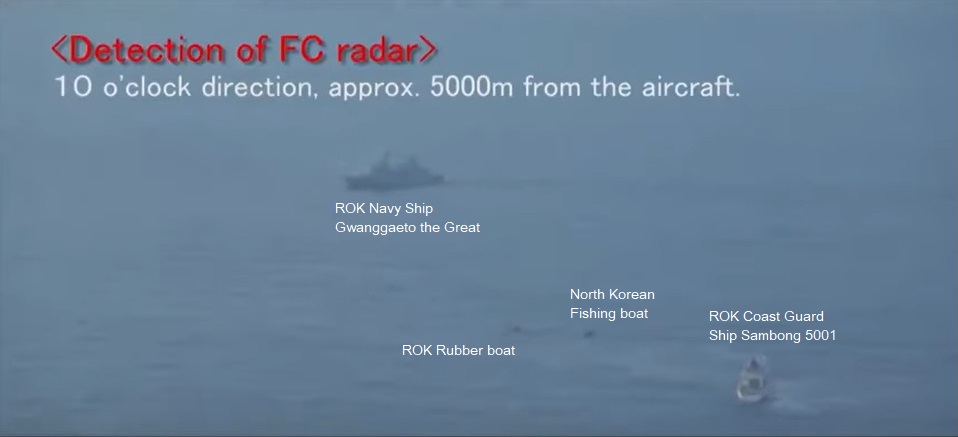
The Japanese patrol aircraft captured this scene and the aircraft’s radar warning receiver (RWR), which sensed the fire control radar, went off with a loud tone after Gwanggaeto destroyer arrived. The loud tone from RWR occurred several times in the video.
In August 2022, which is after Moon Jae-in’s presidency ended, it was revealed that the Moon government ordered ROK Navy ship captains to respond aggressively to Japan’s sea patrol aircraft flying close to them at low altitudes, such as by fire control (추적) radar. This is an extremely hostile and dangerous policy set by Moon, but one that would delight China and North Korea. It is unclear whether this policy is still in effect in the South Korean Ministry of National Defense. Interestingly, this order does not apply to Chinese and Russian aircraft, which violated the KADIZ (Korea Air Defense Identification Zone) numerous times.
Why Would Moon Jae-in risk a conflict with Japan over a boat with defectors? It appears the Moon administration wanted to hide what was occurring. It succeeded by chasing away the Japanese surveillance aircraft, preventing it from making further observations. The Moon administration may also wanted to prevent the defectors going to Japan; Japan would not have sent them back to North Korea.
What happened afterwards has not been widely reported in the media, like so many other cases of defectors escaping North Korea by boats, and then being forced to return to North Korea by the Moon administration. The Moon government kept the story about the two fishermen defectors forcibly repatriated to North Korea in 2019 hidden, until a relevant phone text message was photographed and made public. At that time, a ROK Lieutenant Colonel sent a text message to Kim Yu-geun (김유근), who was the 1st Deputy to the National Security Advisor (국가안보실 1차장) at the Blue House, about sending the two young defectors to North Korea at 3 p.m. on November 7, 2019. On that day, Kim was called to the National Assembly for a hearing, where a photographer captured his phone text message screen.
The context and the fate of the three North Korean military officers, who escaped North Korea, but were captured by the South Korean warship sent by the Moon Jae-in government, would also have been unknown in South Korea. Now Kang Cheol-hwan explains the backstory that they were part of an anti-Kim regime group. It turns out that there was an interview by a former Japanese official about the boat floating at sea on December 20, 2018, which was carrying four North Korean military officers, who escaped after attempting to assassinate Kim Jong-un. Admiral Katsutoshi Kawano, former Chief of Staff of the Japanese Self-Defense Forces’ Joint Chief of Staff, stated, “Attempts by the North Korean military to assassinate…Kim Jong Un in the Wonsan-Kalma region had been unsuccessful. Four people escaped that day and were headed to Japan by sea.” He also stated the South Koreans deployed the Gwanggaeto destroyer after North Korea made an emergency hotline contact via the then-newly established inter-Korean liaison office in Kaesong (which North Korea blew up later), requesting the boat (and those fleeing after the failed attempt) be returned.
This is a serious case. This case, along with hundreds of other cases of forcible return of defectors to North Korea, most likely to their deaths, should be investigated. Defectors from North Korea automatically receive South Korean citizenship per the ROK constitution, and should be accorded the rights and responsibilities of ROK citizens, including protection by the South Korean government. Human rights and national security reasons also require investigations. We need a full accounting of every Korean returned to North Korea in the 5 years of the Moon administration.
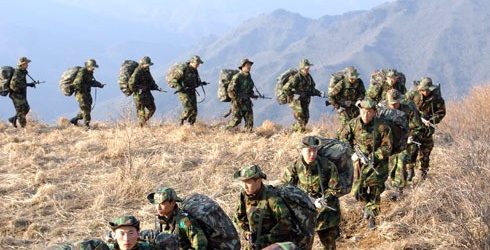

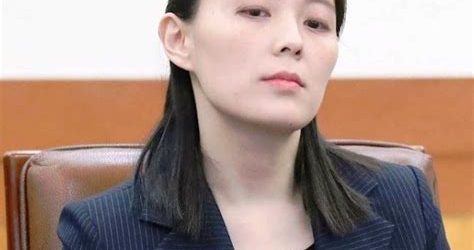

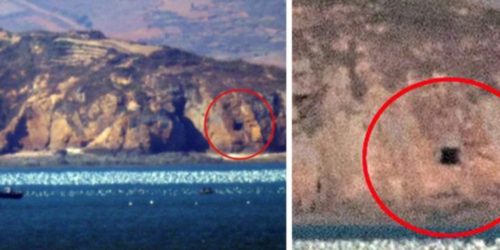
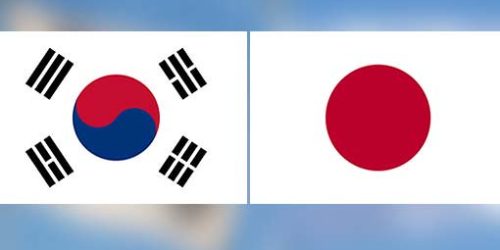
I feel sick. 31 March 2018: I had the opportunity to see some North Korean boats at the DMZ Museum near the Unification Observatory in Koseong, on the East Coast of the Republic of Korea. I am shocked to learn how many boats and defectors were turned back to the Kingdom of North Korea. Is there no end to such depravity and travesty?